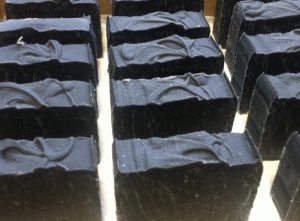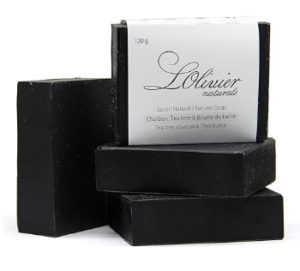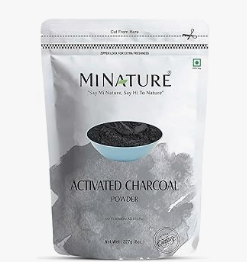Activated Charcoal Soap Recipe

Learn how to make Activated Charcoal Soap with this easy DIY Soap Recipe
So you are wondering……What is Charcoal Soap?
Charcoal soap is a deep cleaning, detoxifying soap that is made with Activated Charcoal.
Activated Charcoal is a natural carbon that is produced when natural ingredients like bamboo, coconut husk, willow, or wood are heated to a temperature between 600-1200 degrees Celcius. Doing this produces Activated Charcoal which creates small pores in the carbon making it a great absorbent.
The use of this activated charcoal soap can actually help to open the pores of the skin and draw out dirt while at the same time detoxifying the skin. Adding this ingredient to your soap will leave your skin feeling clean and a great benefit is that this ingredient also has powerful antibacterial and antifungal properties.
These properties are one of the reasons this bar soap is one that sells year-round and is often used for mature skin as well as teenagers suffering from acne.
Some Questions I have been asked about Charcoal Soap
One question people often ask is if the bathtub or towels will be stained black from this soap.
My answer is no. I have never had anything stained black from this soap and I use it on a regular basis.
Another is “Will this soap dry out my skin”
Also, no. With the natural skin-loving oils that are used when making this soap. It will leave your skin feeling clean and refreshed.
An interesting fact about Charcoal is that it has been used for many years as a detoxifier, not only in soap but as a poultice to keep wounds clean and as an antidote to poisons.
You can read more about it here:
To make Charcoal soap use Recipe #1
Recipe #1
-
-
-
- 800 Grams of Olive Oil
- 450 Grams of Coconut Oil
- 300 Grams Palm Kernal Oil
- 250 Grams of Palm Oil
- 250 Grams of Grapeseed Oil
- 420 Grams of Lye (Sodium Hydroxide)
- 4.5 Cups Water
- for a scented bar, add:
- 2 ounces of scent
- for charcoal soap add 8 tsp of Activated Charcoal.
- The charcoal should be added once the lye/water mixture is added to the oils and mixed thoroughly.
I don’t normally add scent to my charcoal bar as it is a facial bar, although I know people do add tea tree as tea tree oil is used as an effective essential oil in the treatment of acne.
-
-
-
Activated charcoal powder
- It is my personal preference to not scent this bar as I am usually selling it to women with more mature skin looking for a bar that will help to clean and reduce the size of their pores rather than as a treatment for acne.
Basic Cold Process Soap Making InstructionsBefore starting gather all the equipment and ingredients you will need for your soap
Mixing your ingredients:
-
-
-
-
-
-
-
-
- Put on your protective clothing, apron, safety goggles, gloves, etc
- Measure your water and pour it into the container you will be using for your lye/water mix
- Measure out your lye (sodium hydroxide)
- Slowly add the lye to the water, stirring to be sure it mixes well. This should be done in a well-ventilated area as the fumes can be quite strong. This will only last for 15 seconds or so. Stir until the lye is completely dissolved in the water. It will heat up to about 180 degrees and can now be put aside to cool down.
- While the lye/water is cooling use a scale and measure each of your soap oils and put them into your stainless steel pot.
- Place this pot on your stove or hot plate and turn on low to heat to approximately 130 degrees.
- Once the oils have heated to 130 degrees take off the stove or hot plate and let them cool down to about 100 degrees.
- When the lye/water mix and the oils are both cooled down to about 100 degrees they are ready to be mixed.
- Slowly add the lye/water mix to your soap oils and stir you can use a stick blender and hand mix. Mix the soap until it traces. This is when the soap begins to thicken; you can test this by using your spoon to drizzle the liquid into the pot. You will see a trace that stays on the surface of the soap mixture.
- Once the soap has been traced this is the time to add your scent and color.
- Mix the scent and color well
- Pour this mixture into the lined molds, cover it with a piece of cardboard or plastic, put it to bed (place a blanket over the soap mold), and let set for a day or two.
- Once it has sat for a day or two, remove the soap from the mold and cut and put it out to cure for 4 to 6 weeks.
-

4 Bars Activated Charcoal Bar Soap with Tea Tree and Shea butter
-
#handmadesoap #naturalsoap #makingsoapnaturally #soapmaking #soapmaking #soaps #artisansoap #bathandbody #cpsoap #coldprocesssoap #etsy #soapbase #soapcrafter #soapmaker #soaping #soapcrafting #soaphandmade #soap #giftidea #christmas #barsoap #handmadesoap #natural #organic #skincare #coldprocess #soapsupplies #charcoalsoap #blacksoap
-
-
-
-
-
-
- It is my personal preference to not scent this bar as I am usually selling it to women with more mature skin looking for a bar that will help to clean and reduce the size of their pores rather than as a treatment for acne.
© 2017 – 2024, Tes. All rights reserved.

Activated charcoal is one of the hottest trends in the beauty world right now. Completely natural, it actively works to clarify, exfoliate and purify the skin. You can use it from head-to-toe without drying out your skin.
Yes activated charcoal soap is one of my best soaps. It is great for all different skin types from aging to people with acne.